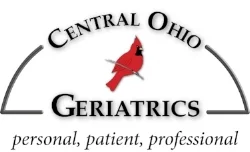By John M. Weigand
Director of Geriatric Services
Central Ohio Geriatrics
Age-related macular degeneration, or AMD, is an eye disease that causes poor vision in more than 10 million older Americans. The retina is the inner layer of the eye that captures light and turns it into electrical impulses. These electrical signals are transmitted by the optic nerve to the brain, which processes and translates them into visual images. The most sensitive part of the retina is the macula, which is the area that is responsible for sharp, detailed central vision necessary for reading, recognition of faces and is important for safe driving. With AMD, this sharp central vision is lost, but the peripheral or side vision is preserved.
Risk factors for AMD include advancing age, white race, a family history of AMD and smoking. There are two types of AMD, dry and wet. Dry AMD is the more common type and represents about 90 percent of the cases. The macula slowly breaks down because of small yellow deposits called drusen. It can develop so gradually that you might not notice the changes in vision at first. Wet AMD is less common (10 percent of the cases) but it is generally more rapid and severe. Wet AMD is caused by leakage of blood and fluid behind the retina, due to abnormal blood vessels. Sometimes dry AMD can turn into wet AMD.
One symptoms of early wet AMD is that straight lines appear wavy. Blind spots or blurriness may develop near your central field of vision. Other symptoms include difficulty adjusting to low light and a decrease in the intensity of colors.
It is important to have regular eye examinations after the age of 50, even if you do not have any symptoms. If you have AMD in one eye, your other eye may be compensating so that you do not notice any changes in your vision. Your doctor can give you an Amsler Grid, which looks like graph paper with thick lines. If the lines start to look wavy, this may be a sign of wet AMD and you should see your eye doctor immediately.
Prevention of AMD is best accomplished through the development of healthy habits, such as quitting smoking, maintaining a regular exercise routine, normal blood pressure and cholesterol levels and eating a healthy diet. People who eat fish and green leafy vegetables may be at lower risk of AMD. There is no treatment for early dry AMD, although a special combination of vitamin and mineral supplements (antioxidant vitamins and zinc) may slow the progression of dry AMD in some people with more advanced disease. Early intervention for wet AMD can delay progression. One treatment is to inject a medicine into your eye to block the growth of abnormal blood vessels. A special form of laser therapy may slow progression but unfortunately cannot restore vision that is already lost.
For more information about AMD, ask your physician, email us at Central Ohio Geriatrics or check out one or more of the following outstanding websites:
• National Eye Institute: www.nei.nih.gov/health/maculardegen/armd_facts.asp
• Mayo Clinic: www.mayoclinic.com/health/macular-degeneration/DS00284
• Agency for Healthcare Research and Quality: http://guideline.gov/content.aspx?id=14275
• American Academy of Ophthalmology: www.geteyesmart.org/eyesmart/diseases/amd.cfm
Please suggest any topics you would like to read about that pertain to senior health care by emailing COG at info@cog-med.com!
Resource: Goodman DM et al. Age-Related Macular Degeneration, JAMA, 308 (16), p. 1702.
